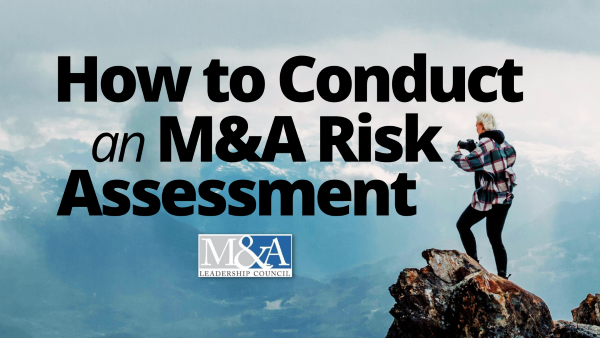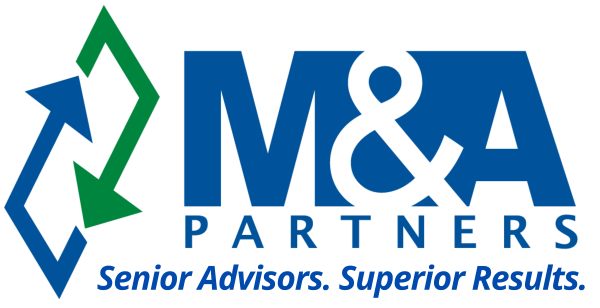
A Step-by-Step Guide
By M&A Leadership Council
An M&A risk assessment is a systematic evaluation process used to identify, analyze, and mitigate potential risks associated with a merger or acquisition. The primary goal is to ensure that the transaction aligns with strategic objectives and minimizes potential negative impacts.
The assessment covers a wide range of areas, including financial, operational, legal, regulatory, cultural, and strategic aspects of the deal.
Key Components of an M&A Risk Assessment
1. Financial Risks:
- Valuation Risks: Ensuring the target company's valuation is accurate and fair.
- Debt and Liabilities: Identifying any hidden debts or contingent liabilities.
- Revenue and Profitability: Assessing the stability and sustainability of the target's revenue streams and profit margins.
- Cash Flow: Evaluating the target's cash flow position and liquidity risks.
2. Operational Risks:
- Operational Efficiency: Analyzing the efficiency and effectiveness of the target's operations.
- Supply Chain: Identifying potential disruptions in the supply chain.
- Technology and Systems: Assessing the compatibility and scalability of IT systems and technology infrastructure.
- Production Processes: Evaluating the robustness and flexibility of production processes.
3. Strategic Risks:
- Market Positioning: Ensuring the target's market position aligns with strategic goals.
- Synergies: Identifying potential synergies and value creation opportunities.
- Competitive Landscape: Analyzing the impact of the acquisition on competitive positioning.
4. Cultural Risks:
- Corporate Culture: Assessing the compatibility of corporate cultures.
- Employee Morale: Evaluating potential impacts on employee morale and engagement.
- Management Styles: Identifying differences in management styles and potential conflicts.
5. Legal and Regulatory Risks:
- Compliance: Ensuring the target complies with relevant laws and regulations.
- Litigation: Identifying ongoing or potential legal disputes.
- Regulatory Approval: Assessing the likelihood of obtaining necessary regulatory approvals.
6. Market and Competitive Risks:
- Customer Base: Evaluating the stability and loyalty of the customer base.
- Market Trends: Analyzing market trends and potential shifts.
- Brand Reputation: Assessing the strength and reputation of the target's brand.
7. Integration Risks:
- Integration Planning: Developing a detailed post-merger integration plan.
- Timeline: Establishing realistic timelines for integration activities.
- Stakeholder Management: Managing communication and expectations with key stakeholders.
Steps in Conducting an M&A Risk Assessment
1. Preparation:
Define the scope and objectives of the risk assessment:
- Determine the specific goals and outcomes desired from the risk assessment.
- Clarify the timeline and key milestones for the assessment.
- Identify the geographical scope, business units, and functions involved.
- Set clear criteria for success and measurable indicators.
- Ensure alignment with overall M&A strategy and corporate objectives.
- Establish communication protocols and reporting structures.
Assemble a cross-functional team with expertise in finance, operations, legal, HR, and strategy:
- Identify and recruit team members with relevant experience and skills.
- Assign roles and responsibilities to each team member.
- Ensure representation from all critical functional areas.
- Provide training or briefings on the M&A process and risk assessment.
- Facilitate collaboration and information sharing among team members.
- Establish regular meetings and checkpoints to review progress.
2. Data Collection:
Gather relevant data and documents, such as financial statements, legal filings, operational reports, and market analyses:
- Collect historical and current financial statements, including balance sheets, income statements, and cash flow statements.
- Obtain legal documents, such as contracts, litigation records, and regulatory filings.
- Review operational reports, including production data, supply chain information, and efficiency metrics.
- Analyze market research and competitive analyses to understand market positioning.
- Gather data on human resources, including employee contracts, benefits, and organizational structure.
- Ensure data integrity and accuracy through validation and verification processes.
3. Risk Identification:
Identify potential risks in each key area (financial, operational, strategic, etc.):
- Financial risks: credit risk, liquidity risk, market risk, and valuation issues.
- Operational risks: supply chain disruptions, production inefficiencies, and IT system vulnerabilities.
- Strategic risks: market competition, regulatory changes, and technological advancements.
- Legal risks: compliance issues, intellectual property disputes, and contractual obligations.
- Human resources risks: employee retention, cultural integration, and leadership continuity.
- Environmental and social risks: sustainability concerns, community impact, and reputational damage.
Use tools such as SWOT analysis, PEST analysis, and risk matrices:
- Conduct SWOT analysis to identify strengths, weaknesses, opportunities, and threats.
- Utilize PEST analysis to assess political, economic, social, and technological factors.
- Develop risk matrices to evaluate and prioritize risks based on likelihood and impact.
- Engage stakeholders in brainstorming sessions to uncover hidden risks.
- Leverage industry benchmarks and best practices to identify common risks.
- Use scenario planning to explore potential future risks and their implications.
4. Risk Analysis:
Assess the likelihood and impact of each identified risk:
- Use quantitative methods, such as statistical analysis and probability models, to evaluate likelihood.
- Assess impact using qualitative criteria, such as financial loss, operational disruption, and reputational damage.
- Develop risk assessment scales to standardize evaluations.
- Involve subject matter experts to provide insights and validate assessments.
- Consider interdependencies and cascading effects of risks.
- Document assumptions and uncertainties in the risk analysis process.
Prioritize risks based on their potential effect on the transaction:
- Rank risks using a risk matrix that plots likelihood against impact.
- Identify high-priority risks that require immediate attention and mitigation.
- Allocate resources and assign responsibilities for managing top risks.
- Develop a risk register to track and monitor prioritized risks.
- Ensure alignment of risk priorities with strategic objectives.
- Communicate risk priorities to key stakeholders for transparency and alignment.
5. Risk Mitigation:
Develop strategies to mitigate or manage each identified risk:
- Implement financial hedging and insurance solutions for financial risks.
- Enhance operational controls and processes to reduce operational risks.
- Formulate strategic initiatives to address market competition and regulatory changes.
- Strengthen legal compliance and intellectual property protections.
- Develop retention programs and cultural integration plans for human resources risks.
- Implement sustainability initiatives and community engagement programs.
Create contingency plans for high-impact risks:
- Develop detailed action plans for responding to risk events.
- Identify key triggers and early warning indicators for activating contingency plans.
- Assign roles and responsibilities for executing contingency plans.
- Conduct simulations and drills to test the effectiveness of contingency plans.
- Ensure availability of resources and support for contingency measures.
- Regularly update and refine contingency plans based on lessons learned and new information.
6. Monitoring and Reporting:
Continuously monitor identified risks throughout the M&A process:
- Establish key performance indicators (KPIs) for tracking risk exposure.
- Implement real-time monitoring systems and tools.
- Conduct regular risk assessments and updates to reflect changing conditions.
- Engage in ongoing communication with functional areas to gather risk-related information.
- Use dashboards and reporting tools to visualize risk data.
- Ensure alignment of monitoring activities with overall risk management framework.
Regularly report findings and updates to key stakeholders:
- Develop standardized reporting formats for consistent communication.
- Schedule regular meetings with senior management and the board to review risk status.
- Provide clear and concise summaries of risk assessments and mitigation efforts.
- Highlight significant changes in risk exposure and their implications.
- Solicit feedback and input from stakeholders to refine risk management strategies.
- Ensure transparency and accountability in risk reporting practices.
7. Review and Adjustment:
Periodically review the risk assessment and adjust strategies as needed based on new information or changes in circumstances:
- Schedule regular review sessions to evaluate the effectiveness of risk mitigation strategies.
- Update risk assessments to reflect new data, market conditions, and organizational changes.
- Re-prioritize risks based on current risk landscape and strategic objectives.
- Adjust mitigation plans and contingency measures to address emerging risks.
- Document and communicate changes in risk management approach to stakeholders.
- Foster a culture of continuous improvement and learning in the risk management process.
Is it advisable to conduct your own M&A Risk Assessment?
Conducting your own M&A risk assessment can be beneficial and advisable in certain situations, particularly if you have the necessary expertise and resources. Here are some factors to consider when deciding whether to do your own M&A risk assessment:
ADVANTAGES OF DOING YOUR OWN M&A RISK ASSESSMENT
- Cost Savings:
- Avoiding the high fees associated with hiring external consultants or advisory firms
- In-Depth Understanding:
- Gaining a deeper understanding of the target company and the potential risks involved
- Enhancing internal knowledge and capabilities
- Customization:
- Tailoring the risk assessment to specific needs and objectives
- Focusing on areas most relevant to your organization
- Confidentiality:
- Keeping sensitive information within the organization
- Reducing the risk of leaks or exposure
CHALLENGES AND CONSIDERATIONS
- Expertise and Resources:
- Ensuring your team has the necessary expertise in financial, legal, operational, and strategic analysis
- Availability of time and resources to conduct a thorough assessment
- Objectivity:
- Maintaining an unbiased perspective and avoiding internal biases
- Ensuring critical risks are not overlooked due to familiarity or assumptions
- Comprehensiveness:
- Covering all aspects of the assessment thoroughly
- Leveraging the right tools and methodologies for accurate analysis
WHEN TO CONSIDER EXTERNAL ADVISORS:
- Complex Transactions:
- When the deal involves complex financial structures, cross-border elements, or significant regulatory considerations
- Lack of Internal Expertise:
- If your team lacks experience in M&A transactions or specific areas of the assessment
- Need for Objectivity:
- When an independent, third-party perspective is crucial for unbiased risk evaluation
- Time Constraints:
- If the timeline for the transaction is tight and internal resources are stretched
HYBRID APPROACH:
Many organizations opt for a hybrid approach, combining internal efforts with external expertise:
Internal Team:
- Conducting preliminary assessments and gathering data
- Identifying initial risks and areas of concern
External Advisors:
- Providing specialized expertise in specific areas (e.g., legal, financial)
- Validating internal findings and offering an independent perspective
- Assisting with complex analysis and due diligence
Conducting your own M&A risk assessment can be advantageous if you have the necessary expertise, resources, and an objective approach. However, for complex transactions or when specific expertise is lacking, involving external advisors can add significant value and ensure a thorough and unbiased assessment. A hybrid approach can often provide the best balance, leveraging internal knowledge while benefiting from external expertise.
------------------------------------------------------------------------------------------------------------------

M&A Partners is ready to help your organization conduct an M&A risk assessment, either in a hybrid or full-service capacity. Have an acquisition coming up, but still not ready to tackle the risk assessment? Consider our Executive Briefing, at your place of business -- a no-cost, four-hour meeting with your leadership team to determine your organization's state of M&A readiness. Call 866-394-3690 to find out details.
